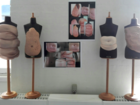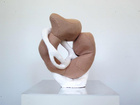Theory Lab: Gender and Body Ethics

Theory Lab lasts a week beginning with a theory session and ending in a gallery presentation where students show their 3D interpretations of elements and themes from the theory they found particularly pertinent for them as future designers.
In the theory session of “Ethics, Gender and Body”, second year fashion students read and discussed texts by philosopher Lars Svendsen and sociologist Fred Davis as well as an article from The Atlantic on the role of body and gender in fashion.
The students explores a number of conceptual approaches to push or even break with gender normative roles and contemporary body ideals. The takes were often highly personal while also engaging in broader societal issues.
The contributions included sculptural explorations of the fixation on unrealistic body ideals in contemporary selfie culture; a celebration of the bulging belly as an inspiring shape; a visual statement that dramatized the notion that all objects are inherently gendered by applying pink as a gender cliché to everyday objects such as milk, nasal spray and batteries; a framed portrait capturing Protestant work ethic and capitalism as an overlooked condition for current gender perceptions; draping with garments selected from Pinterest generated norms of feminine and masculine to create deliberately awkward poses on a chair as a way of blurring gender perceptions; and a video documentation communicating surveillance of the body with special attention to the collarbone as a sculptural element.
The students used a wide range of materials for these explorations including felt, wax, clay, video, plaster, paper and latex. This diversity speaks to the equally broad takes on gender and body as an ethical concern for fashion designers.
The final results, presented in this gallery, are intended to open up for conversations on gender and body through visual concepts triggered by theory.














